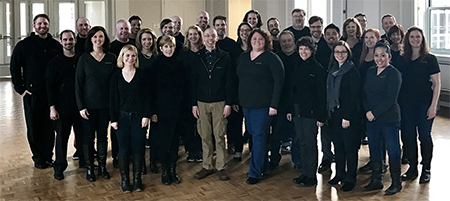by Timothy Robson

Pietà enters a long and historic line of choral works which combine liturgical or quasi-sacred texts with poetry or prose that complements the sacred text. Johann Sebastian Bach’s Passions and Benjamin Britten’s War Requiem are famous examples. Muehleisen’s 90-minute setting is for soprano and tenor soloists, treble choir, male “chanting” choir, mixed chorus, two English horns doubling oboes, percussion, and organ.
He chose a diverse set of texts, including words by Rudyard Kipling, Wilfred Owen (the same poet set by Britten in the War Requiem), and William Blake, in addition to the Roman Catholic Stabat Mater, a Civil War-era popular song, and excerpts from the funeral homily for Matthew Shepard, the 21-year-old gay man who died in 1998 following a hate crime attack in Wyoming. Several texts were set to chorales from the Bach Passions, notably Owen’s “One ever hangs where shelled roads part,” so miraculously set by Britten. The work ends with the mid-19th-century hymn “O God of Love, O King of Peace.”
Perhaps the most striking aspect of Pietà is its use of an unaccompanied men’s chorus chanting parts of the Orthodox liturgy for Good Friday as a framework surrounding the other poetry. It is not a biblical text, but a vividly detailed commentary on the events of Jesus’s trial and execution. The young men of the Stoney Creek Choir, with a couple of adult “extras,” were highly effective from their unseen location at the far east end of the nave. The young women from Stoney Creek had somewhat less to do, but they made several radiant appearances at the musical climaxes of Pietà, especially in “Show Us Thy Glorious Resurrection” toward the end, followed by ecstatic repetitions of the word “Glory” by all of the choruses. This movement was the highlight of the performance.
Muehleisen’s musical style in Pietà ranges from simple, diatonic song to highly chromatic, almost atonal passages. Sounding Light was well-prepared, singing with a beautifully blended sound and a wide dynamic range, and always with purity of intonation. Although the full text of the work was printed in the program booklet, I was happy to be seated close to the front of the cathedral, where the sound and words were clear and direct. There were times where the percussion parts threatened to overtake the choral singing and soloists.
Brian Giebler’s high lyric tenor was true in sound and intonation, and captured the emotions of the text. Perhaps his most effective moments were in the unaccompanied Civil War song, “Just Before the Battle, Mother.” It was heartbreakingly simple, although its relationship to the Passion story was not clear. In the huge choral passages, he sometimes had to push his voice to be heard. Likewise, Lindsay Kesselman’s lovely lyric soprano seemed almost overwhelmed in the climaxes. She was fierce in the many angular lines she was given.
Despite an expert performance, I was left feeling that the text selections weren’t cohesive enough to bind Muehleisen’s work together, and the diverse musical styles made the work seem too lengthy. The use of the Orthodox chants as a kind of choral narration was brilliant, but in other places, the texts only diluted a point already made. The idea of using a congregational hymn at the end may have been a good one, but its style was jarring after the brilliant exclamations of the resurrection.
Published on ClevelandClassical.com March 18, 2019.
Click here for a printable copy of this article



